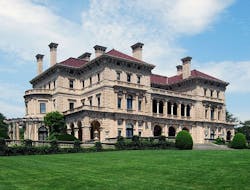There is nothing small about Rhode Island’s microgrid ambitions.
The Breakers, the Newport summer home of the late Cornelius Vanderbilt II. Credit: Matt Wade Photography
The state has hired a consultant to develop a statewide microgrid project. The project wrapped up at year end 2016, and the report on that effort is being compiled and is expected by the end of April.
But even before the state began looking at microgrids, the city of Newport was working on a resiliency program that has turned into a portfolio of 12 projects, including a three-phase microgrid project. The first phase, which calls for a microgrid for critical infrastructure, could be in operation as early as year end, says Paul Carroll, Newport’s director of civic investment.
Newport’s head start could prove useful for the rest of the state. The route Newport is taking could serve as a template for future microgrid projects, Carroll says, and even serve as a model that could be rolled out nationwide.
The need for Newport’s resiliency program, which also includes urban agriculture and an innovation zone project, was driven home by Superstorm Sandy in 2012.
While only two Rhode Island counties were hit by Sandy, it became clear to city officials that the risk of being hit by some form of devastating storm is rising. “We will probably be hit by a category two hurricane within the decade,” says Carroll.
Another major problem quickly became clear. As Carroll put it, “there is less and less money available” for those kinds of projects.
The solution was to turn to the city’s “legacy” families, the scions of the wealth that put Newport on the map with the mansions they built along Bellevue Avenue in the 19th Century.
Carroll says the families came up with $250,000. That prompted the city to find $500,000 in its budget. But he could see that he would have to find another way to fund the projects the city envisioned. So the city decided to recruit the private companies, and in 2015 issued a national request for proposals (RFP) to attract private sector investors.
The RFP resulted in the formation of a consortium that includes Infralinx Capital, engineering and architecture firm The Louis Berger Group, construction company Gilbane, the Denton law firm, and G2 Investments.
The consortium formed the Newport Project Development Co. (NPDC). The development company, which includes two finance companies, Infralinx and G2, is handling the raising of capital, as well as design and construction of the planned microgrid.
National test case
NPDC also has wider ambitions. The company is looking at the Newport project as both a national test case and as an incubator focused on resiliency planning around ocean related climate change. The project also prove to be a national test case of how the public sector and private sector can come together with investors to develop civic infrastructure.
While the development company has national ambitions, Carroll says the process Newport used to put together the development – from planning and conducting the solicitation to negotiating the final arrangements – could provide valuable lessons for other cities facing similar climate related threats.
Newport’s efforts have already gotten some traction at the national level. Last spring Newport’s Department of Civic infrastructure and the NPDC participated at the Department of Commerce’s Global Cities Challenge competition.
While some of the other cities may have been more advanced smart city projects, Carroll says participants were impressed that Newport, alone among the 100-plus participating cities, saw the need for private sector funding and included impact investors from the inception of the project.
Newport also has formed alliances with university research centers, including Harvard University and the Massachusetts Institute of Technology, and forged a strategic alliance with the University of Maryland.
The University of Maryland’s Environmental Finance Center is now exploring how Newport’s resilience program and its use of private sector funding might be applied as a model at the national level.
Three phase microgrid plan
In terms of the microgrid itself, Newport is rolling it out in three phases. The first phase will provide resiliency in the form of backup and potential islanding for the city’s critical infrastructure.
“In the case of a severe storm, the city has to be prepared to be without power for up to 30 days,” says Carroll.
[clickToTweet tweet=”There is nothing small about Rhode Island’s #microgrid ambitions.” quote=”There is nothing small about Rhode Island’s microgrid ambitions.”]
The first phase would involve a strip in the city that includes the police and fire departments, city hall, the junior high school (which would serve as a shelter), and the Newport hospital.
The second phase would include a microgrid for the city’s waste water treatment facility and the urban agriculture infrastructure. The third phase would serve the innovation district that is being built on 40 acres of unused land where the city’s major bridge, the Pell Bridge, touches down.
The first microgrid will include solar power installations and energy storage capabilities and will form the basis for the design of the subsequent phases. The details of the plan, including negotiations with the developer, are still being worked out, as are the details of the power purchase agreement between the city and the developer. Those negotiations could be complete by the end of April, says Carroll.
At the state level, Carroll says he sees “strong and growing momentum” for the role Rhode Island could play in being a leader in resiliency innovation, especially under Gov. Gina Raimondo.
There is a growing realization of the role collaboration can play in innovation, says Carroll, a realization that “the sum can be greater than the parts.”
Track news about Rhode Island’s microgrid plans by subscribing to the Microgrid Knowledge newsletter. It’s free.







